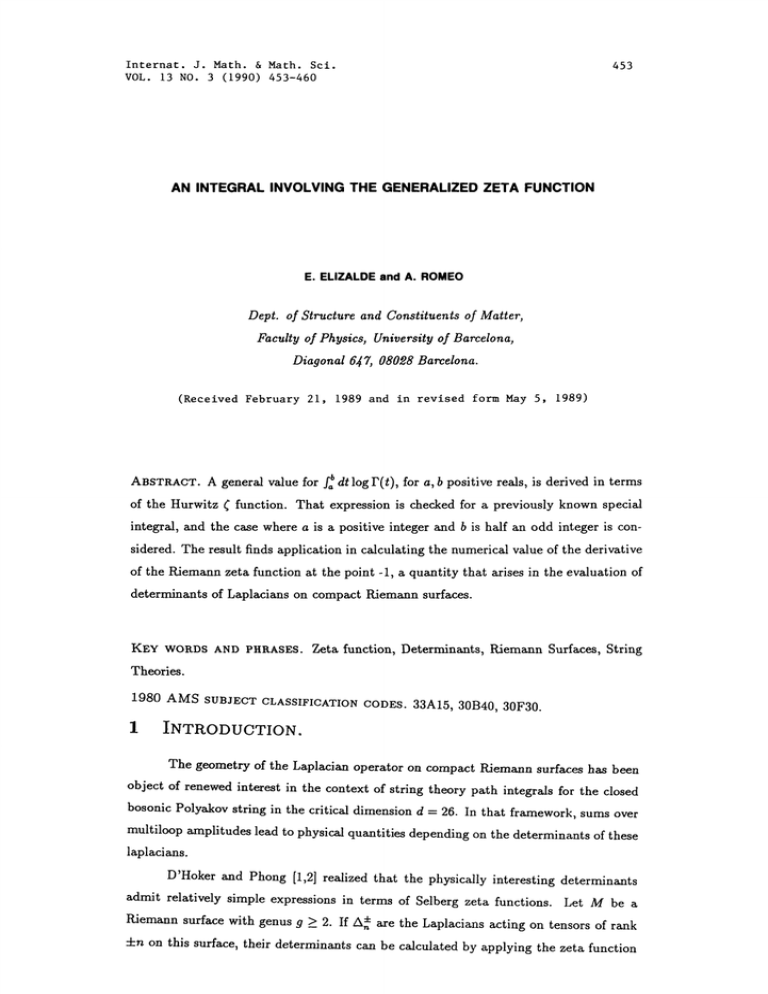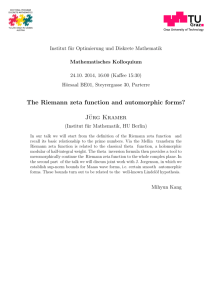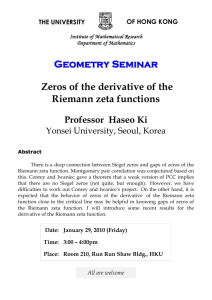f of 6 P(t),
advertisement

Internat. J. Math. & Math. Sci.
VOL. 13 NO. 3 (1990) 453-460
453
AN INTEGRAL INVOLVING THE GENERALIZED ZETA FUNCTION
E. ELIZALDE and A. ROMEO
Dept. of Structure and Constituents of Matter,
Faculty of Physics, University of Barcelona,
Diagonal 6 7, 080e8 Barcelona.
(Received February 21, 1989 and in revised form May 5, 1989)
ABSTRACT. A general value for
f dt log P(t), for a, b positive reals, is derived in terms
of the Hurwitz ( function. That expression is checked for a previously known special
integral, and the case where
a is a
positive integer and b is half an odd integer is con-
sidered. The result finds application in calculating the numerical value of the derivative
of the Riemann zeta function at the point -1, a quantity that arises in the evaluation of
determinants of Laplacians on compact Riemann surfaces.
KEY
WORDS AND PHRASES.
Zeta function, Determinants, Pdemann Surfaces, String
Theories.
1980 AMS SUBJECT CLASSIFICATION CODES.
33A15, 30B40, 30F30.
1
INTRODUCTION.
The geometry of the Laplacian operator on compact Riemann surfaces has been
object of renewed interest in the context of string theory path integrals for the closed
bosonic Polyakov string in the critical dimension d 26. In that framework, sums over
multiloop amplitudes lead to physical quantities depending on the determinants of these
laplacians.
D’Hoker and Phong [1,2] realized that the physically interesting determinants
admit relatively simple expressions in terms of Selberg zeta functions. Let M be
a
Riemann surface with genus g > 2. If
are the Laplacians acting on tensors of rank
A
4-n on this surface, their determinants can be calculated by applying the zeta function
E. ELIZALDE AND A. ROMEO
454
method, which establishes
Det’/k exp(- ’(0)),
(
(I.i)
operator zeta functions, the prime on Det means deletion
of the zero mode, and the other means derivative with respect to s. For the sake of
where
are the associated
0, corresponding to the Laplacian acting
clarity, let us focus on the case n
on scalar
functions. It turns out that the associated zeta function can be split into two pieces
0() + 0()
0()
with
g- 1
() ,/;r()
/.o
h
(1.3)
/ g_(/2).
On the other hd M c be identified with H/F, the action of some Fuchsian
group F on the upper hMf-ple H {z x + iy y > 0} endowed with the Poinc6
metric ds
y-=(dz +dye). Going one step further, D’Hoker and Phong [2] have shown
that, introducing the Selberg zeta function
H
z()
H( 1 e-’+’),
(1.4)
prim. p=0
where the first product runs over the interconjugate primitive elements ? of F and
e the lengths of the corresponding geodesics meured with the Poinc metric
McKe [3])
one
gets
’
’(0)
(.)
-log z’(1).
elt result about which we e not going to me y further cogent
We will, inste turn to }. The vMue given by D’Hoker and Phong [2] is
That is
here.
l(v)
(see
( ’(0) ( 1)
which coincide wigh formul
-log2 +
(.)
4(’(-1)
(24e) in [4], (s)is he memann et function.
Then from
(t.1), (1.)a (1.),
he
eoneng congns
number d
put
ghe
’
(-1)
a
-’ ’(".
relent contg, so some undersding of
(1.6) would be desireble.
derivagion of (1.), we would
igs occurrence
emphi on he
z’()
in
ghis
While D’Hoker d Phong
[2]
like to go over the cMculation
leading to (1.6) in some degN1 in the next section, chk the degree of non-trivielity of
gh result, d obtNn possible methemeticM consequences.
In pgicul, we hM1 be led to derive explicit expression (non-existent to our
knowledge in ghe maghemegicM ligerure) for the integrN of log r(t) betwn y two
in Secg. a. In Sect. 4 it will be restricted to the
positive reN, he rulg being
ven
pticul c theg we need explicigly, d in Secg.
a series expsion
which converg very tepidly will be obtned on the bis of this anMysis.
for
((-1)
455
GENERALIZED ZETA FUNCTION
THE
2
Let
us now
turn to expression
one can
ZETA FUNCTION IN
(1.3). K,,(x)
e).
can be put as
k-
r
g,(x)
Then,
RIEMANN
ROLE OF THE
2sinru o
((x/2) u!) (/9_)+)
+ u!)
(2.1)
k!(k
k!(k-
plug (2.1) into (1.3) d take advantage of the integr representation
for the Hurwitz generalized zeta function
fo
(z,q)
As
a
dt
tz-le -tq
1-e -t’
(2.2)
lez> 1, q>0.
result, two formal series show up
0(,)(s)
--0
g
i((3/- ))
2-+ F(k + s)
(2k + 2s
r(,)r( + 1)
k=O
where use h been made of the
gala
’ /)
(e +
r()r( + /e- )
()
function reduplication formula.
0 and k
It should be noticed that the terms with k
need a bit of care. Taking into account the expansion
evaluating the derivative at s
1, 1/2)
in the first summatory
,
(q) + 0(e) and
((1 + q)
0 one gets
ds
=0-
=
(, /)
(2"- 1)(),
2 k+
l(k’ 1/2)
(2.4)
Since
the series that h ppeared gives rise to expsions of the form
(-1)
=z
one c recM1 that
[5]
ogt
with t
F(t + 1)
d
-v +
(-)"()t", for-
<
(.)
(n) z" Then,
n+l
,
(e.)
denoting the Euler-Mcheroni constant. So the expansions in
question c be interpreted
1o r(z + 1)
1
[,+
7
(2.7)
where a ptiN integration h been peormed. The vMues we need are precisely
and
1/2. or
1, he result is known, d reads
f] dt log r()
Differentiating (2.g) d bering in nd the identity (1/2)
-7
-1
+ 1/2log 2.
2 log2, one can
reach the intermediate result
o(> ’(0)
-(g- ) [-’(-) + (e(-)- e)og e- e +
-4
ff/ dt log r(t)],
og
(.8)
E. ELIZALDE AND A. ROMEO
456
1/2. As the expression
where the integral comes from the series corresponding to z
stands, this is the only unknown term.
In addition,
an integral like this one was considered by Steiner
[4]
in connection
with the evaluation of the Selberg zeta function for a Laplace operator acting on scalars
on a Riemann surface. There the result was given with the aid of the
A second observation is the following. Had
we taken
Barnes G function.
A instead of A0 (see[2]),
after carrying out a similar calculation we would have ended up with
3
INTEGRATION
f+3/ dt log F(t).
log
OF
We will follow a quite simple procedure based on two formulae for partial deriva-
,
tives of the generalized zeta function given by
(s,t)
In addition, it admits
for s
1
k=0 (k + t)"
(2.2),
for Re s > 1,
which can also be defined as
(3.1)
# 0,-1,-2,...
an analytic continuation that makes it
regular for every s, except
1, where it has a simple pole. Derivation of (3.1) with respect to gives.
-ff(s, t)
--s(s -i- 1, t).
(3.2)
On the other hand, it has been long known (e.9. Erd61yi et al. [5], pg. 26) that the
partial derivative of the Hurwitz zeta function with respect to s at s
0 is related to
Euler’s gamma function by
,o t)
ss((S
log F(t)- log 2r, Re > 0.
(3.3)
o=0
By partial derivation of (3.2) with respect to s, one is led to
0s0t
((s, t)
-((s + 1, t)
s
(s + 1, t),
and, after applying (3.2) again, to
i)
0& (’ t)
which is valid for s
-;(, t) sO( +
0
# 0, 1. At this point,
,
(3.4)
t),
it is important to notice that for s
Re > 0, ((s, t) is
-
(3.)
1, and
an analytic function of s and t, and therefore, the partial derivatives
with respect to s and to commute in this region. Besides, by taking s
-1 and
making use of (3.3), we obtain
0
Otas(S t)
0
s=-I
-’(s, t)
+ log r(t)
log 2r.
(3.6)
s=--I
When integrating the above expression with respect to
over a
positive real interval
dtlogF(t)= (-1, t) + ’(-1, t) + log 2r
(3.7)
(a, b), we get
GENERALIZED ZETA FUNCTION
457
’(-1, t) denotes -7((s t)
Eq. (3.7) is the desired general formula and one of the main results in this
paper. Although, it is valid for a, b > 0, we feel that it can be extended to any pair of
negative reals provided that there is no singularity of the F function between them, i.e.
to any interval containing neither the origin nor negative integers. In the usual integral
handbooks (see e.g. Grhbner and Hofreiter [6]) only the special case b a + n, n 5 N
where
appears. One can also find a more general result based on the Barnes G function, which
generalizes Euler’s gamma function
(see Steiner [4]
and references therein) but, to our
"
knowledge, no result in terms of hgs been listed.
As a way of testing (3.7), let us check a previously known case, whose result
be found in several places (e.g. Erddlyi et al. [5] pg. 24), namely,
/-
can
2
=0
When evaluating this particular integral according to (3.7), we get the differences
(-1, a + n)
(-1, a) d ’(-1, a + n)
’(-1, a). For
our purpose, we can
te
advantage of the identity
(,,a + n)
(s, a)-
(k + a)-’,
(a.9)
k=O
trivially obtained from (3.1). The point of this expression is that, while (3.1) w valid
just for s > 1, the second term on the r.h.s, of (3.9) is finite for any value of s. Besides,
both
(s, a+n)d (s, a)adt Mytic contuations to s < 1. Therefore (3.9) m&es
< 1 we. The same reoning pplies to its derivative with respect to s:
sense for s
’(,, + ,)
Since both
’(,, ) + ( + )o( + ), eo, #
o
(3.9) and (a.0) hdd for y s #
,
they can be taken at s
.
(3.0)
-1, where they
turn out to be
[(-1,a + n)
’(-1, a)-
(k + a),
(3.1)
k=0
’(--1, a q- n)
"(--1, a) q- (k q- a)log(k q- a).
(3.12)
k=-0
By taking (a.7) for
a
+n
and plugging the above identities into the r.h.s., we
immediately see that the result is the same as the one given by
4
PARTICULAR
We
(a.8)
CASES.
are interested in the case where the lower limit of integration is a positive
integer and the upper limit is half an odd integer, i.e.
I(m,n) =_ f=++l/=dt log F(t),
m
e N, n e N*.
(4.1)
E. ELIZALDE AND A. ROMEO
458
A possible way of calculating this would be to replace a with m and b with m + n + 1/2
(3.7) However, there is an alternative method which shows that all the
integrals of the type (4.1) reduce to known quantities plus I(1, 0), i.e. plus an integral
from 1 to 3/2.
on the r.h.s, of
By splitting the integration region into two pieces,
fZ+"dt log r(t) + ::+a/dt log r(t),
I(m,n)
the first intergal can be read from
(4.2)
(3.8). As for the second one, it is convenient to make
t- m- n + 1 and take advantage of the simple relation
the obvious variable change u
re+n--2
log F(u + m + n
]
1)
log(u + k) + log F(u).
(4.3)
k=0
can be immediately
Then, the terms in the summatory
integrated. As a result of all
this, (4.1) becomes
m--1
klogk +
I(m,n)
i
re+n--1
(2kW1)tog(2k+l)
k=l
k=l
--ran--
n(.- I)
I
1
--:(re+n--I)-- :(m+n)’Iog2--:
2
+: log 2r + 1/2d log r(u).
(4.4)
So, the question of knowing the value of I(m,n) boils down to calculating the
integral from 1 to 3/2, that will be now quickly evaluated. (3.7) tells us that
j’:/dt log r(t) (-1, 3/2) ((-1) + ’(-1, 3/2) ’(-1) + tog 2r,
(4.5)
(s), being (s) the Riemann zeta function.
From (3.9) and the relation (2.5)it is plain that
where ((s, 1)
(2"
(s, 3/2)
(4.6)
1)(s) 2".
Derivation of this expression with respect to s yields
(4.7)
:’(s, 3/2) (2" log 2)’(s) + (2" 1)"(s) 2" log 2.
Once again, by analytic continuation (4.6) and (4.7) are valid for any s # 1. In particular, they can be taken at s -1, thus obtaining
3
(4.8)
and
3
1
:(log 2)((-1) .,(’(-I)
("(-I, :)
Plugging them into (4.5),
we
: log2.
get
’(-1) 4
dtlogF(t)
1
-: + : log2) ((-1)
-(1 + log2)+
log 2r,
459
GENERALIZED ZETA FUNCTION
which allows us to write
(4.4)
as
re+n--
n--1
dt log r(t)
k log k
(2k + 1)log(2k + 1)
+
k=l
k=l
(- l)
2) (-)
+ n+ 1/2 o.
The
(.)
emn eta funcgion at he poing -1 is well known,
-e2
(-1)
-Z12
(.
1/6 being the second Bernoulli number), bug ghe remble feature of expresa relevant mathematic constt for the
sion (4.11) is the fct that ’(-1) appes
cMculagion of his fily of informs.
hese results, combined with (2.8), Mlow us to recover (1.6).
(B
5
CALCULATION
OF
(’(-1).
A numerical value for (’(-1)
was given
by Steiner [4], pg. 452, namely ’(-1)
_
-0.1655. It was obtained by taking a finite number of terms of the asymptotic expansion
for (’(-1,q) given by Elizalde in
[71 (see also Fried [8]). Nevertheless, in the case q
the validity of that approximation seems to be, at first sight, difficult to justify. Here
we will find the value of
’(-1) by means of using the preceding results.
There is at least one alternative way of evaluating the integral on the 1.h.s. of
(4.10). After doing a trivial variable change, making use of the power series (2.6) and
"
,
with
(5.1)
1
4
2
1
7
7
log2+ logr+m
2
36
integrating term by term, we get
Using
(4.12), a comparison of (4.10)
’(-1)
(--i)=
(n).
(5.1)
leads to
(-I)"
-’2
which provides us with an expression to evaluate
ically calculated. Eq.
(5.2)
’(-1), since the r.h.s,
is another main result in this paper.
can be numer-
For the even-n terms,
we have applied the relation
(2.)
(2)
(-)+’ 2(2)t,
.z
N’,
(.a)
where B2, is he 2rnta Bernoulli number. As for the odd-n terms, we have used the
definition of the Pdemann zeta function,
1
k=l
E. ELIZALDE AND A. ROMEO
460
and approximated
(n)
with finite sums up to the desired accuracy. The outcome of
doing all that is
(’(-i)
(5.5)
-0.16542115...,
in good agreement with the value given by Steiner
[4].
Notice, moreover, the rapid
convergence of the series in (5.2), which can be numerically checked. In fact, using a
simple Pascal program we have got the stability of the first six figures of (5.5) after
summation of only eleven terms of the series in
(5.2).
ACKNOWLEDEGEMENTS
Thanks are given to the referee of a previous version of this paper for useful
CAICYT, research project AE(A. R.) has also obtained financial help through an FPPI grant,
advice. This work has been partially supported by the
87-0016-3. One of us
Programa Areas de Conocimiento, from MEC Spain, during the last stage of this work.
PEFERENCES
[1] D’Hoker, E. and Phong, D.H., On Determinants of Laplacians
faces, Commun. Math. Phys.
[2] D’Hoker, E.
String,
269
Sur-
10__4 (1986) 537-545.
and Phong, D.H., Multiloop Amplitudes
Nud. Phys. B
on Riernann
(1986)
for
the Bosonic Polyakov
204-234.
[3] McKean, H.P., Selberg’s Trace Formula as Applied to a Compact Riemann Surface,
Commun. Pure Appl. Math 2_.5 (1972) 225-246.
[4] Steiner, F., On Selberg’s zeta function for compact Riemann surfaces, Phys.
B 188 (1987) 447-454.
Let:
[5] Erd61yi, A., Magnus, W., Oberhettinger,F., and Tricomi, F.G., Higher Transcendental Functions, Mc Graw-Hill, New York, 1953.
[6] GrSbner, W., and Hofreiter, N., Integralta:ffel,
Zweiter Teil, Springer Verlag, Wien,
1973.
[7] Elizalde, E., Derivative of the generalised Riernann zeta function (z, q) at z -I,
J. Phys. A 18 (1985) 1637-1640, and An asymptotic expansion for the first derivative of the generalized Riemann zeta function, Math. of Computation, 4__7, 175
(98) Z47-0.
[8] Fried, D., Analytic torsion and closed geodesics
Math. 84 (1984) 523-540.
on hyperbolic
manifolds, Invent.









